阅读理解专项训练(学案)
阅读专项训练教案
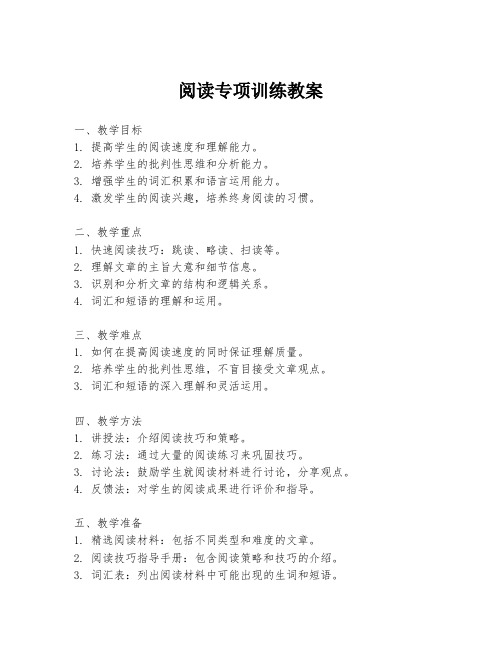
阅读专项训练教案一、教学目标1. 提高学生的阅读速度和理解能力。
2. 培养学生的批判性思维和分析能力。
3. 增强学生的词汇积累和语言运用能力。
4. 激发学生的阅读兴趣,培养终身阅读的习惯。
二、教学重点1. 快速阅读技巧:跳读、略读、扫读等。
2. 理解文章的主旨大意和细节信息。
3. 识别和分析文章的结构和逻辑关系。
4. 词汇和短语的理解和运用。
三、教学难点1. 如何在提高阅读速度的同时保证理解质量。
2. 培养学生的批判性思维,不盲目接受文章观点。
3. 词汇和短语的深入理解和灵活运用。
四、教学方法1. 讲授法:介绍阅读技巧和策略。
2. 练习法:通过大量的阅读练习来巩固技巧。
3. 讨论法:鼓励学生就阅读材料进行讨论,分享观点。
4. 反馈法:对学生的阅读成果进行评价和指导。
五、教学准备1. 精选阅读材料:包括不同类型和难度的文章。
2. 阅读技巧指导手册:包含阅读策略和技巧的介绍。
3. 词汇表:列出阅读材料中可能出现的生词和短语。
六、教学过程(一)导入(5分钟)1. 激发兴趣:通过简短的故事或问题,引起学生对阅读的兴趣。
2. 明确目标:向学生说明本节课的学习目标和重要性。
(二)新课讲解(15分钟)1. 介绍快速阅读技巧,如跳读、略读、扫读等,并解释每种技巧的适用场景。
2. 讲解如何抓住文章的主旨大意,识别文章的结构和逻辑关系。
3. 分享词汇学习策略,如上下文猜测词义、同义词替换等。
(三)实践练习(20分钟)1. 分发阅读材料,让学生尝试运用快速阅读技巧。
2. 指导学生如何标记文章中的关键信息和生词。
3. 让学生总结文章的主旨大意,并尝试用自己的话复述。
(四)小组讨论(15分钟)1. 将学生分成小组,每组讨论阅读材料的内容和结构。
2. 鼓励学生分享自己的理解和观点,进行思维碰撞。
3. 每组选出代表,向全班展示讨论结果。
(五)词汇学习(10分钟)1. 列出阅读材料中的生词和短语,进行讲解和举例。
2. 让学生尝试用这些词汇造句,加深理解和记忆。
专项复习三 阅读理解学案

专项复习三 阅读理解学案对于阅读理解的解题技巧,大多是对学生作答技巧的归纳。
分为步骤法和题型法。
步骤法:快速阅读全文+认真逐题作答+复查校对答案 题型法:细节理解+猜测词义+推理判断+主旨大意大多数学生做阅读理解时,先精读文章,然后做题,这样的优点是做题有底气,详细掌握文本内容,缺点是耗费时间,受复杂句子干扰。
另一种是先仔细研读试题题干和选项,带着问题去文章中找答案,这种做法优点是节约时间,缺点是考生基本功要扎实,遇到复杂题目往往一知半解。
根据实际情况,考生可以灵活掌握。
若文章短可先读短文,后看文后题目;如果文章太长,你可以先把文章后面的问题看一遍,带着问题去看文章。
这样可以帮助你去掉杂念,提高阅读速度和解题的正确性。
或者,考生先精读首段和其余各段首句,把握文章的中心和结构,然后细读问题,锁定答案区域。
1.审标题,抓中心标题是文章主题的高度凝聚。
试题中有的文章有标题,有的没有,它能给我们启发和想象,想象文章的内容和走向。
2.览全文,知全貌快速通读全文,了解全文的梗概。
要善于找关键句,特别要注意文章的第一段和最后一段的头一句话。
每段的第一句,常包含了全文的主要信息或基本观点;而结尾部分一、细节理解题通过阅读短文,可以直接从阅读材料中找到这类问题的答案,常考查的方面有事件发生的时间,地点,原因,方式,过程,结局,人物之间的关系,事件之间的关系,词和句的含义等,通过快速阅读扫描确定该细节在文中的出处(信息源),仔细对照题干要求,排除或选择。
事实细节题设题手段单一,常常针对文章中某个容易误解的关键词句或概念,通过移花接木的手段组成是非辨别选择题,难度较小,属浅层理解题。
1.常见的提问形式:1) 是非判断类型Which of the following is NOT mentioned in the passage?Which of the following statements is NOT true?2)特殊疑问词提问类型How many……?What/who/when/where/how/why……? 3)排序题类型Which of the orders is correct according to the passage?4)例证题类型The author gives the example in……paragraph in order to ……2.解题方法1)是非判断一般都遵循对照选项进行“三对一错或三错一对”的判断。
小学语文阅读理解题型练习教案资料
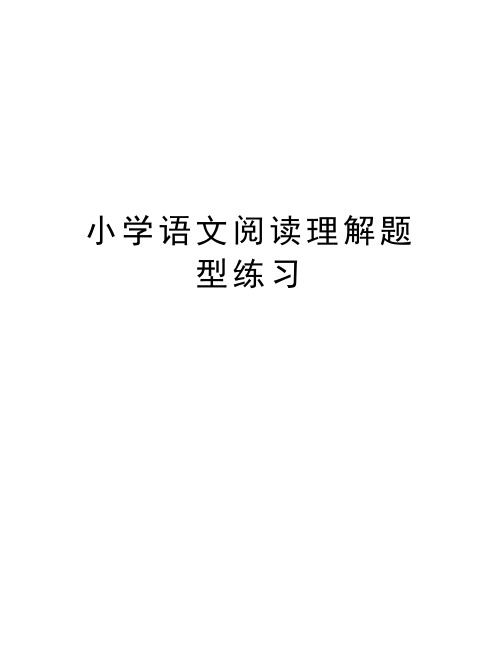
小学语文阅读理解题型练习小学语文阅读理解题型练习小学阅读教学的重点是培养学生对语言文字的感受理解、积累和初步的运用能力。
高年级的阅读重点是提高阅读的速度和质量,体会词语的感情色彩,句子的含义及表达效果,揣摩文章的叙述顺序,领悟文章的表达方法等。
阅读理解考察的内容包括:理解词语,体会句子的含义,概括段落的主要内容,揭示文章的思想以及对文章关键人物的评价等。
下面我来谈谈在阅读理解短文上的一点想法:要在阅读上有所突破,首先要培养习惯,读懂文章后再动笔。
什么叫“读懂文章”,我做了这样一些界定:读完文章后,(1)要知道这篇文章写的是什么?写人还是写事,写景还是写物?(2)作者写这篇文章是要表达某种情感还是说明某个道理?(3)我能概括出文章的内容。
(4)我能用想回答好这五个问题,文章不读上三遍是不可能一下子弄清楚的。
因此教育孩子阅读短文,文章至少读三遍,读第一遍,标小节号,题目边上写清楚:写什么;读第二遍时,想文章的内容,是抒情还是说理,题目的作用是什么读第三遍时,写中心词或者在文中勾画中心句,作者表达什么。
正如叶圣陶所说:“一篇文章要理解的透,必须多揣摩,读一遍,再读第二遍,第三遍……”每读一遍都有事情可做,孩子的读有目的,读懂文章是完成阅读题的关键。
阅读理解题型及解答方法一、联系上下文理解词语——瞻前顾后所谓“瞻前顾后”具体是指联系文章前后文的句子明确词义,在具体语境中揣摩词义的变化,用自己最通俗的语言表达出来。
其实解释词语的方法有很多,找近、反义词;抓住关键词解释等,在基础部分复习时大家一定会注意的。
二、理解句子的含义,谈谈自己读句子的体会——字面+中心+生活。
所谓“字面+中心+生活实际”指的是,先理解句子的字面意思,解释句中的关键词语,连词成句;联系文章前后的内容来解释句子,联系文章中心来理解句意,最后要结合自己的生活实际来谈感受,作者写文章的目的是表达自己的情感,或者说明一个道理,希望与我们达到共鸣,我们要联系自己的生活,来谈体会。
牛津上海版六年级下阅读理解完形填空专项练习
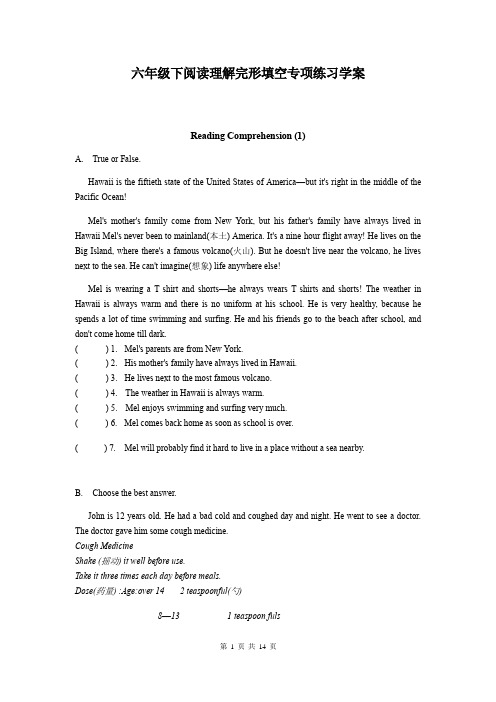
六年级下阅读理解完形填空专项练习学案Reading Comprehension (1)A.True or False.Hawaii is the fiftieth state of the United States of America—but it's right in the middle of the Pacific Ocean!Mel's mother's family come from New York, but his father's family have always lived in Hawaii Mel's never been to mainland(本土) America. It's a nine-hour flight away! He lives on the Big Island, where there's a famous volcano(火山). But he doesn't live near the volcano, he lives next to the sea. He can't imagine(想象) life anywhere else!Mel is wearing a T-shirt and shorts—he always wears T-shirts and shorts! The weather in Hawaii is always warm and there is no uniform at his school. He is very healthy, because he spends a lot of time swimming and surfing. He and his friends go to the beach after school, and don't come home till dark.( ) 1. Mel's parents are from New York.( ) 2. His mother's family have always lived in Hawaii.( ) 3. He lives next to the most famous volcano.( ) 4. The weather in Hawaii is always warm.( ) 5. Mel enjoys swimming and surfing very much.() 6. Mel comes back home as soon as school is over.( ) 7. Mel will probably find it hard to live in a place without a sea nearby.B.Choose the best answer.John is 12 years old. He had a bad cold and coughed day and night. He went to see a doctor. The doctor gave him some cough medicine.Cough MedicineShake (摇动) it well before use.Take it three times each day before meals.Dose(药量) :Age:over 14 2 teaspoonful(勺)8—13 1 teaspoon fuls4 — 71/2 teaspoonfulNot right for children below the age of three. Put it in a cold place. Use it before December 1 st, 2009.( ) 8. Why did John cough day and night? Because he_____________.A. had a feverB. had toothacheC. had a headacheD. had a bad cold() 9. John should take _____________ a day.A. 2 teaspoonfulsB. 3 teaspoonfulsC. 4 teaspoonfulsD. 1teaspoonful()10. The medicine should be kept in ______________ .A. a fridgeB. hot waterC. any placeD. thesun( )11. John should____________before he takes it.A. shake the medicine wellB. eat dinnerC. do some exerciseD. drink a cup of tea( )12. When people are___________ years old, they cannot take this medicine.A. eightyB. thirtyC. twoD.twelve()13. John will__________ the medicine when it is left after Dec. 1st, 2009.A. throw awayB. stop to takeC. take onceD. take six times more( )14. What can we know from this passage?A.We should do more exercise.B.We take cough medicine according to(按照) what the doctor says.C.We can buy cough medicine.D.We can drink only in the evening.C. Choose the words or expressions and complete the passage.Uncle Tom is15than before. He always16the factory very early and is17 late.He usually goes to bed18 ten o'clock at night, and he 19TV for only one hour every day. He does exercises for about six 20 every week, and21 a lot of fruit and vegetables.( )15. A. health B. more health C. much healthier D. healthiest( )16. A. reaches B. goes C. comes D. walks ( )17. A. always B. often C. usually D. never ( )18. A. before B. after C. about D. on ()19. A. sees B. looks C. watches D. watch ( )20. A. weeks B. days C. minutes D. hours ( )21. A. ate B. eating C. eats D. eatD.Read the passage and fill in the blanks with proper words.City people are always busy. They are always in a h 22. That is why they like supermarkets. You can buy things q 23and easily in a supermarket. If you w24 something, you just put it in your basket. You do not ask, "How m 25does this cost?" The p 26are on all the cans and packages. Then you t 27your basket to a checkout to pay and then g 28away.22. h_________ 23. q ________ 24. w ________ 25. m ________ 26.p_________27. t __________ 28. g________E.Answer the questions.You know Bill Gates is the head of Microsoft Company and the world's richest man. But what else do you know about him? See what we found for you on the internet:Bill Gates was born on October 28, 1955. His full name is William Henry Gates III. (Editor's note: Bill is the pet name of William. )He was born and grew up in Seattle, USA.He entered Harvard University in 1973 but dropped out(退学) in 1975.If you change all of Bill Gate's money to 1-dollar notes, you can make a road from the earth to the moon, about 10 times back and forth (来回).He can donate(捐款) 7 dollars to everyone on the earth and still has around $ 50 million for his pocket money.In 1996, Bill Clinton won the US Presidential Election(美国总统大选) with a total of 47,401,185 votes(选票). If Bill Gates wanted to be President, he could easily pay each voter(投票者) 870 dollars and buy 47,401,186 votes(one more than Clinton got) with his money.If Michael Jordan doesn't drink and eat, and keeps up his income(收入), $30 million each year, he'll have to wait for more than 150 years to become as rich as Bill Gates.29. Who is Bill Gates?30. When was Bill Gates born?31. Where did he grow up?32. When did he enter Harvard University?33. When did Bill Clinton win the US Presidential Election?34. How many dollars can he donate to everyone on the earth and still have a lot of pocket money?35. If Bill Gates wanted to be President what could he do?【Keys】1. F2. F3. F4. T5. T6. F7. T8. D9. B10. A 11. A 12. C 13. A 14. B 15. C 16. A 17. D 18. A 19.C 20.D 21. C22. hurry 23. quickly 24. want 25. much 26. prices 27. take 28. go29. He is the head of Microsoft Company and the world's richest man.30. On October 28, 1955. 31. He grew up in Seattle, USA.32. He entered Harvard University in 1973. 33. In 1996. 34. 7 dollars.35. He could easily pay each voter 870 dollars and buy 47,401,186 votes (one more than Clinton got) with his money.Reading Comprehension (2)A.True or False.Too politeThere are many people in the bus. Some have seats, but some have to stand. At a bus stop, a woman gets on the bus. An old man hears the door and tries to stand up."Oh, no, thank you," the woman forces him back to the seat. "Please don't do that. I can stand. ""But, madam, let me ..." says the man."I ask you to keep your seat," the woman says. She puts her hands on the old man's shoulder.But the man still tries to stand up, "Madam, will you please let me ... ?" "Oh, no," says the woman. She again forces the man back.At last the old man shouts, "I want to get off the bus!"( ) 1. All the people have seats in the bus.( ) 2. An old man gets on the bus at a bus stop.( ) 3. The old man wants to give his seat to the woman.() 4. The woman sits the old man's seat.( ) 5. The old man wants to get off the bus.( ) 6. This passage tells us the woman was too polite.() 7. The man was angry at last.B.Choose the best answer.Over thirty thousand years ago, people from Northern Asia(亚洲北部) went to America. Today, we call these people Indians(印第安人). The Indians went to America because the weather began to change. Northern (北部的) Asia became very cold. Everything froze. They had to move or they would die. How did the first Indians go to America? They walked! Later, Columbus found the New World in 1492. At first, only a few Europeans followed(跟随). They travelled to America in boats. For the next three hundred years, about 500,000 people went there. Then the number grew very quickly. From 1815 to 1915, over thirty-two million Europeans left their countries and went to the United States. The biggest groups were from Germany and Italy (意大利). These Europeans spoke many different languages. Most of them took almost no money. They went to America so that they could find a better life.( ) 8. ______________went to America first.A. Peopie from northern AsiaB. People from EuropeC. People from GermanyD.Columbus( ) 9. Why did the Indians go to America? Because______________ .A.northern Asia became very hotB.northern Asia became very coldC.they were interested in AmericaD.they liked traveling( )10. The New World was_______________ .A. ItalyB. northern AsiaC. GermanyD. America( )11. How did the first Indians go to America? They ___________________ !A. walkB. walkingC. walkedD. walks ()12. The first Europeans went to America_________________ .A. by shipB. by bikeC. by boatD. by train()13. These Europeans____________ .A. didn't speak the same languageB. spoke English onlyC. spoke German onlyD. spoke both English andGerman( )14. Why did they go to America?A.They could make money.B.They could find a better life.C.They want to settle down in America.D.They want a busy life.C. Choose the words or expressions and complete the passage.Alice and Mike are very good friends. They are in the same15at school and they often visit each other's home at the weekend. Now they are16 eight years old. Alice's mother has got a new baby. Alice is very 17to have a littlesister. So she is always talking about her to Mike. At first Mike is very 18in the new baby because he doesn't have any brothers or sisters. But19some time he begins to20 Alice's endless talking about it. But Alice didn't know her friend felt very21 . What should Mike do with the problem?( )15. A. grade B. table C. class D. group()16. A.all B.two C.both D.either()17. A.angry B.sorry C.surprised D.glad()18. A.interesting B.interested C.happy D.pleased()19. A.before B.for C.after D.at()20. A.get rid of B.like C.dislike D.hate()21. A.interested B.excited C.surprised D.boredD.Read the passage and fill in the blanks with proper words.There are four s22 in a year; spring, summer, autumn and w 23 . Spring is the first season o 24the year. When spring comes, the w 25 is warmer and the days get 126 .It often r 27. I like spring b 28 .22. s ________ 23. w _______ 24. o_______ 25. w________ 26. 1 _______ 27. r ________ 28. b_______E.Answer the questions.All over the world, people enjoy sports. Sports help to keep people healthy, happy and to live longer.Many people like to watch others play sports games. They buy tickets or turn on their TVs to watch the games. Often they get very excited when their player or team wins.People play different games in winter and summer. Swimming is fun in warm weather, but skating is good in winter.Some sports are so interesting that people everywhere go in for them. Football, for example,had spread around the world. Swimming is popular in all countries near the sea or in those withmany rivers.Some sports or games go back thousand of years, like running, jumping or discus-throwing.But basketball and volleyball are rather new.29. What do people enjoy all over the world?30. What is the best game in winter?31. What game is popular all over the world?32. What games have a long history in the world?33. Many people have their "own" player or team, don't they?34. How do sports help people?35. What games are new?【Keys】1. F2. F3. F4. F5. T6. T7. T8. A9.B 10. D 11.C 12. C 13. A 14. B 15. C 16. C 17. D18. B 19. C 20. C 21. D22. seasons 23. winter 24. of 25. weather 26. longer 27. rains 28. best29. They enjoy sports. 30. Skating. 31. Football.32. Running, jumping or discus-throwing. 33. Yes, they do.34. They help to keep people healthy, happy and to live longer. 35. Basketball and volleyball.Reading Comprehension (3)A.True or False.Many parts of the world have four seasons. They are spring, summer, fall and winter. Spring follows winter. It becomes warmer and the days become longer. Plants begin to grow and many animals have babies. Summer is the hottest season. It does not get dark until late. Plants grow fast. In fall the days get shorter. The weather turns cooler. Trees may lose their leaves. Some birds fly to warmer places. Winter is the coldest season. It gets early in the evening. Plants stop growing and many trees are bare(光秃).() 1. All parts of the world have four seasons.() 2.After winter it becomes warmer and the days become longer.() 3.Many animals have babies in spring.() 4.Summer is the hottest season.() 5.The days become longer in fall.() 6.Winter comes. The plants stop growing.()7.Many trees grow fast in winter.B.Choose the best answer.During the day we work and play. At night we sleep. Our body rests while we sleep. In the morning we are ready to work and play again. Our body grows most while we are sleeping. Children usually need more sleep. We can learn our lessons better after we have had plenty of rest Boys and girls who are eight or nine years old need ten hours of sleep every night. Our body needs plenty of air when we sleep. If we do not get enough fresh air, we will feel tried when we wake up. While in bed we must not cover our heads. Our lungs need to get enough fresh air. If we open our window at night, we can have plenty of fresh air. Cool air is better than warm air. Boys and girls who want to be strong must get plenty of sleep.( ) 8. During the day we______________ . At night we sleep.A. workB. work andplayC. playD. play andsleep( ) 9. Our body grows most while we are______________ .A. eatingB. playingC. sleepingD.exercising( )10. Too little sleep makes us______________ .A. tiredB. hungryC. happyD. grow ()11. What may cause us to feel tired in the morning?A. Too much exercising.B. Not enough fresh air.C. Ten hours.D. Elevenhours.( )12. How many hours of sleep should 9-year-old children have?A. Eight hours.B. Nine hours.C. Ten hours.D. Elevenhours.( )13. What do the lungs need most?A. Fresh air.B. To be covered.C. Warm air.D.Exercises.()14. Boys and girls who want to be strong must get_____________sleep.A. a lotB. manyC. moreD.plenty ofC.Choose the words or expressions and complete the passage.We have a two-month holiday in summer, During the 15week of the holidays we get ready16school. We buy pencils, pens, paper, new books and copybooks. On the first day of 17we see all our old friends18 and we tell them about the19. Afterthat we go into our classroom. It is so hard to keep20and listen to our teacher. He alwayssays with a laugh. "You forget 21 in two months than you learn in a year!"( )15. A. first B. second C. third D. last( )16. A. for B. to C. at D. with( )17. A. holidays B. school C. lessons D.summer( )18. A. too B. again C. instead D. first( )19. A. summer B. school C. holidays D.lessons( )20. A. excited B. tired C. quiet D. clean( )21. A. more B. less C. most D. bestD.Read the passage and fill in the blanks with proper words.The w 22in Shanghai is not good. In winter it is very cold. February is m 23colder than January. In spring it is quite w 24. It rains a lot in April. May is w 25and dry. Summer is very h 26 .July and August are theh 27months of the year. Autumn is all right. It doesn't o 28rain.22. w_________ 23. m _______ 24. w______ 25. w _______ 26. h_______ 27. h _________ 28. o ________E. Answer the questions.Most people on Park Road are still asleep when the milkman comes. He brings the milk every morning before 7 o'clock. But he doesn't only sell milk. You can buy eggs, orange juice from him, too. But there isn't an evening newspaper on Sunday. The postman comes twice a day from Monday to Saturday at half past eight in the morning and one o'clock in the afternoon. He goes there by bike. But when the weather is bad, he uses a post office car. A bread van visits Park Road two afternoons a week. Not many people buy bread from the van because it's more expensive than in the shops.29. What do most people on Park Road do when the milkman comes?30. What can you also buy from the milkman?31. When does the postman come?32. On which day can't people read newspaper?33. What does the postman use when the weather is bad?34. How often does the bread van come?35. Why do not many people buy bread from the van?【Keys】1. F2. T3. T4. T5. F6. T7. F8. B9.C 10. A 11. B 12. C 13. A 14.D 15. D 16. A 17. B 18.B 19.C 20. C 21. A22. weather 23. much 24. wet 25. windy 26. hot 27. hottest 28. often29. They are still asleep. 30. Eggs and orange juice.31. From Monday to Saturday. 32. On Sundays.33. A post office car. 34. Twice a week. 35. It's more expensive than in the shops.。
阅读理解练习教案
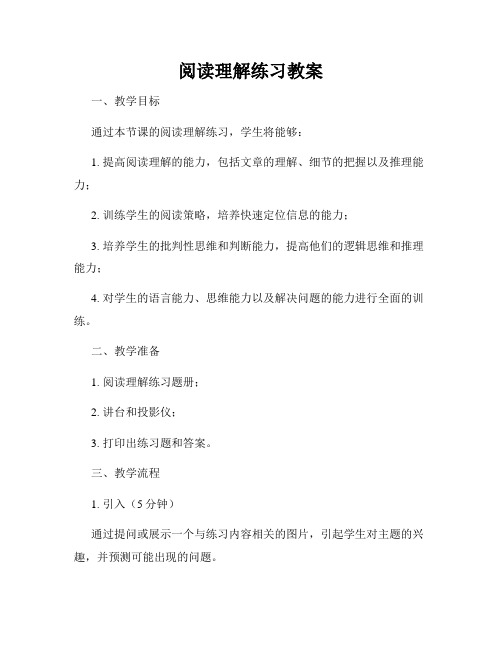
阅读理解练习教案一、教学目标通过本节课的阅读理解练习,学生将能够:1. 提高阅读理解的能力,包括文章的理解、细节的把握以及推理能力;2. 训练学生的阅读策略,培养快速定位信息的能力;3. 培养学生的批判性思维和判断能力,提高他们的逻辑思维和推理能力;4. 对学生的语言能力、思维能力以及解决问题的能力进行全面的训练。
二、教学准备1. 阅读理解练习题册;2. 讲台和投影仪;3. 打印出练习题和答案。
三、教学流程1. 引入(5分钟)通过提问或展示一个与练习内容相关的图片,引起学生对主题的兴趣,并预测可能出现的问题。
2. 阅读理解练习(20分钟)将练习题项目投影到屏幕上,并给学生分发练习题册,让学生在一定时间内阅读并回答问题。
3. 分组讨论(15分钟)将学生分成小组,让他们共同讨论并解决练习题。
鼓励学生积极参与,并指导他们如何推理和解答问题。
4. 答案解析(15分钟)选择几道典型的问题进行公开解答,并对解题过程进行解析和讲解。
同时,鼓励学生提问,互相讨论并共享不同的解决方法。
5. 扩展活动(10分钟)提供一些额外的阅读材料或问题,让学生进行更深入的思考和讨论。
鼓励他们从不同的角度思考问题,并探索其他解决方法。
6. 总结(5分钟)对本节课的内容进行总结,强调学生在阅读理解中需要培养的能力和策略,鼓励他们持续练习和提高。
四、巩固练习提供额外的练习题供学生进行巩固练习,并鼓励他们在课后自主进行阅读理解的训练。
五、教学反思本节课通过阅读理解练习的方式,培养了学生的阅读能力和思维能力。
在教学过程中,学生积极参与,合作讨论并提出问题。
在答案解析环节,学生对于问题的理解和推理能力得到了提高。
但教学过程中可能会存在时间不足的问题,需要在时间安排上进行调整。
另外,对于更加高级的阅读理解题,需要提供更多的实例和练习机会,以满足学生的学习需求。
【备考2023】中考语文一轮 记叙文阅读题型六 学案(含答案)

中考语文现代文阅读指导与训练·记叙文阅读记叙文阅读常见题型解题策略及训练题型六分析插叙作用插叙,是在叙述中心事件的过程中,为了帮助展开情节或刻画人物,暂时中断叙述的线索,插入一段与主要情节相关的回忆或故事的叙述方法。
对这一知识点中考考查的是插叙的作用。
常见题型1.选文xx的内容有什么作用?2.作者插叙xx的事在文中的作用是什么?3.某些段与小说的核心内容看似无关,实则联系紧密,请说明理由。
4 有人说x段应该删去,你觉得呢?说说你的理由。
公式呈现(1)结构:使情节更曲折(或更紧凑)(2)内容:可以更好地展开情节,突出主题(或刻画人物)(3)概括内容+为后文铺垫(引出下文)公式解读总体解读:此公式的几点是兼容的,并且在实际的做题过程中要逐点答出,不能遗漏。
插叙作为一种技巧,都是为中心和主题服务的。
在叙述事件的过程中,作者不惜牺牲事件的连贯性而插人一段文字,那就证明这段文字绝不是可有可无的,而是深思熟虑,要达到某种目的的文字。
具体解读:(1)结构:使情节更曲折(或更紧凑)。
插叙是中断叙事的线索,插人一段与主要情节相关的文字。
这样的文字必然破坏了原有叙事的线索,让整个故事情节更有波澜,从这个角度讲自然就有“使情节更曲折”这个作用。
特别提示:有一些试题.本身这段插叙的内容就是为了“承上启下”“对比”“衬托”等,往往这样的文字在文段中比较明显,那么在实际的答题过程中还是要把这些“对比”“衬托”等相关的内容答上,这样势必会使情节更加紧凑。
(2)内容:可以更好地展开情节,突出主题(或刻画人物)。
在实际的中考阅读中,无论是什么技巧,作者有意识地运用,就一定是为了达到某种目的,而这种目的一定是和主题(或中心)相关的。
需要提醒的是,除了要答出“突出主题”这个“套话”外,还应该答出“主题”的具体内容。
而在一些以写人为主的记叙文或是小说(小说的核心是塑造人物)中,这样的插叙文字就会有“刻画人物”的作用。
在一些以叙事为主的文章中,特别是中考常考的记叙文范畴(或小说范畴),插叙就会对情节产生影响,就有了“更好地展开情节”或是“推动情节发展”的作用。
【备考2023】中考语文一轮 记叙文阅读题型四 学案(含答案)

中考语文现代文阅读指导与训练·记叙文阅读记叙文阅读常见题型解题策略及训练题型四品析环境描写作用环境描写是指对人物所处的社会环境和自然环境的描写。
对记叙性的文章,考查环境描写的作用是常见题型。
同学们按照自己的理解答题都可以拿到部分分数,但是要想在中考的考场上答出更佳的答案,获取更高的分数,就需要在理解文章内容上掌握适当的技巧。
常见题型①文中画线句子的环境描写,有怎样的表达效果?②某文段画横线句是_________描写,在文中的作用是___________。
③从全文看,景物描写的作用是什么?④某段画线部分的景物描写有什么作用?公式呈现(1)烘托__________(人物)心情,渲染______气氛;奠定感情基调。
(2)概括内容+推动情节发展(为后文________铺垫),为后文提供合理依据。
(3)交代故事的时间、地点、背景。
公式解读总体解读:这三个阅读答题公式在实际的答题过程中是互通的。
当然,互通不代表在做任何试题的时候,不管实际的情况如何,都一股脑地堆砌上去,而是应该有选择地运用。
这三个公式,不是“环境描写作用”的全部内容,只是说在中考中可以解决大部分常规性的试题,因此在实际的运用中要做到“活学活用”,切不可脱离文本,只依据答题公式来做题。
公式的横线部分是要添加的具体内容,此步骤非常重要,因为这涉及你对文章的理解,没有这一步,整个回答的过程就变成了形式的堆砌,而不是深人文本答题了。
具体解读:(1)烘托______(人物)心情,渲染_________气氛;奠定感情基调。
这是常规公式的表现情况。
文本中穿插环境描写,肯定是为了表现某个中心,因此往往就有了“渲染”的作用:而中心所表现的如果与人物有关,肯定是为了表现人物的心情。
因此这两个点作为常规考题的必考思路,一般而言,都要答。
有一个小的注意事项,就是有一部分试题的环境描写,不是为了表现人物的心情,也不是为了渲染气氛,而是为了塑造典型环境中的典型人物,因此就有了“塑造(烘托)人物”这个作用。
说明文阅读训练学案
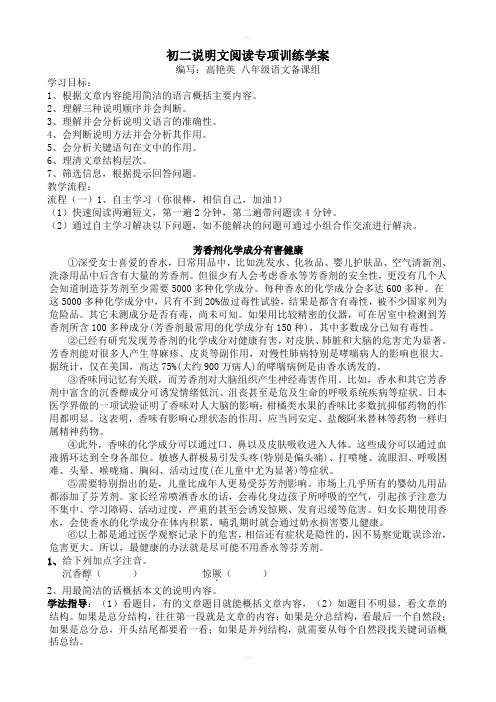
初二说明文阅读专项训练学案编写:高艳英八年级语文备课组学习目标:1、根据文章内容能用简洁的语言概括主要内容。
2、理解三种说明顺序并会判断。
3、理解并会分析说明文语言的准确性。
4、会判断说明方法并会分析其作用。
5、会分析关键语句在文中的作用。
6、理清文章结构层次。
7、筛选信息,根据提示回答问题。
教学流程:流程(一)1、自主学习(你很棒,相信自己,加油!)(1)快速阅读两遍短文,第一遍2分钟,第二遍带问题读4分钟。
(2)通过自主学习解决以下问题,如不能解决的问题可通过小组合作交流进行解决。
芳香剂化学成分有害健康①深受女士喜爱的香水,日常用品中,比如洗发水、化妆品、婴儿护肤品、空气清新剂、洗涤用品中后含有大量的芳香剂。
但很少有人会考虑香水等芳香剂的安全性,更没有几个人会知道制造芬芳剂至少需要5000多种化学成分。
每种香水的化学成分会多达600多种。
在这5000多种化学成分中,只有不到20%做过毒性试验,结果是都含有毒性,被不少国家列为危险品。
其它未测成分是否有毒,尚未可知。
如果用比较精密的仪器,可在居室中检测到芳香剂所含100多种成分(芳香剂最常用的化学成分有150种),其中多数成分已知有毒性。
②已经有研究发现芳香剂的化学成分对健康有害,对皮肤、肺脏和大脑的危害尤为显著。
芳香剂能对很多人产生荨麻疹、皮炎等副作用,对慢性肺病特别是哮喘病人的影响也很大。
据统计,仅在美国,高达75%(大约900万病人)的哮喘病例是由香水诱发的。
③香味同记忆有关联,而芳香剂对大脑组织产生神经毒害作用。
比如,香水和其它芳香剂中富含的沉香醇成分可诱发情绪低沉、沮丧甚至是危及生命的呼吸系统疾病等症状。
日本医学界做的一项试验证明了香味对人大脑的影响:柑橘类水果的香味比多数抗抑郁药物的作用都明显。
这表明,香味有影响心理状态的作用,应当同安定、盐酸阿米替林等药物一样归属精神药物。
④此外,香味的化学成分可以通过口、鼻以及皮肤吸收进入人体。
2025届高考语文复习:信息类文本阅读
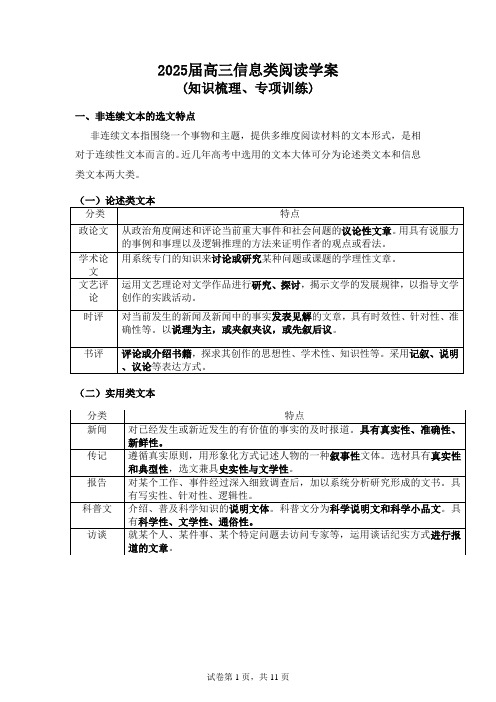
2025届高三信息类阅读学案(知识梳理、专项训练)一、非连续文本的选文特点非连续文本指围绕一个事物和主题,提供多维度阅读材料的文本形式,是相对于连续性文本而言的。
近几年高考中选用的文本大体可分为论述类文本和信息类文本两大类。
分类特点政论文从政治角度阐述和评论当前重大事件和社会问题的议论性文章。
用具有说服力的事例和事理以及逻辑推理的方法来证明作者的观点或看法。
学术论文用系统专门的知识来讨论或研究某种问题或课题的学理性文章。
文艺评论运用文艺理论对文学作品进行研究、探讨,揭示文学的发展规律,以指导文学创作的实践活动。
时评对当前发生的新闻及新闻中的事实发表见解的文章,具有时效性、针对性、准确性等。
以说理为主,或夹叙夹议,或先叙后议。
书评评论或介绍书籍,探求其创作的思想性、学术性、知识性等。
采用记叙、说明、议论等表达方式。
(二)实用类文本分类特点新闻对已经发生或新近发生的有价值的事实的及时报道。
具有真实性、准确性、新鲜性。
传记遵循真实原则,用形象化方式记述人物的一种叙事性文体。
选材具有真实性和典型性,选文兼具史实性与文学性。
报告对某个工作、事件经过深入细致调查后,加以系统分析研究形成的文书。
具有写实性、针对性、逻辑性。
科普文介绍、普及科学知识的说明文体。
科普文分为科学说明文和科学小品文。
具有科学性、文学性、通俗性。
访谈就某个人、某件事、某个特定问题去访问专家等,运用谈话纪实方式进行报道的文章。
二、因文设题,关注文体特征。
(一)论述文的分析论证特点论证特点(特色)论证方式立论:提出论题(论点)—分析问题(展开论证)—解决问题(展开论证)驳论:提出错误观点—批驳错误观点—提出正确观点立驳结合论证方法举例论证:运用概述和具体事实来论证。
真实可信,增强说服力。
引用论证:运用常理与哲理。
增强文章的说服力和感染力。
对比论证:通过事物相反或相异属性比较来揭示论点。
对比鲜明,论证有力。
比喻论证:用人们熟悉的事物来作比。
更生动形象。
阅读基本功训练——理解句子含义(上)-学案

£)第2讲 阅读基本功训练一一理解句子含义(上)fn4 i •了解现代文理解句子含义的考查题型。
2•学会审题,读题。
进一步为现代文阅读打下基础。
3•会用所学理解方法进行现代文阅读的答题。
i .下列各句中有语病的一项是( )A. 这次教训,使他明白细节决定成败的道理,对他大有裨益。
B. 武汉市教育局表示,要支持建设一批公办幼儿园,大力扶持和发展民办幼儿园。
C. 只有虚心听取别人的意见,认真改进缺点,我们才能不断进步。
D. 国家免收义务教育阶段学生学杂费的举措大大减轻了家长的经济负担。
2.下列各句中有语病的一项是( ) A. 写文章的语言要精练,一定要把不必要的罗嗦话统统删去。
B.沿线的拆迁工作能否顺利进行,是地铁 3号线能否如期开通的条件之一。
C. 我市高新区不断完善以市场为导向、以企业为主体、产学研结合的技术创新体系,积极参与"自主创 新综合配套试验区”的建设。
D. 据中科院动物研究所初步鉴定,这头金色牦牛是世界上新发现的一种野生动物,并被命名为“金丝牦 牛”。
3. 下列各句中有语病的一项是( ) A. 那位失主为表谢意昨天在电视台又诚挚地为小赵点了一首歌。
B. 在那些艰难的日子里,不管他的身体有多差,生活条件再不好,精神压力有多大,他都坚持创作。
C. 我们如果不把这本书认真读好,就不谈读别的书了。
D. —篇文章要是字迹过于潦草,即使内容很不错,也是要不得的。
4.下列各句中有语病的一项是( ) A. 养麦具有降低毛细血管脆性、改善微循环、增加免疫力的作用,可用于高血压、高血脂、冠心病、中 风发作等疾病的辅助治疗。
B. 我国专利申请一年比一年多,专利申请的持续快速增长,表明国内研究开发水平在不断提高,社会公 众专利意识在不断增强。
C. 劳动的最后一天是同学们最紧张、最愉快、最有意义的一天。
D. 这是一本好书,它能催人进取,促人猛醒,引人深思。
5. 下列各句中有语病的一项是( )A. 老人那清晰的思路、开朗的性格、乐观的情绪以及坚定的信心,深深地感染了我们。
初中语文阅读专项训练公开课教案

初中语文阅读专项训练公开课教案第一章:阅读理解基本概念与技巧1.1 阅读理解的重要性解释阅读理解在语文学习中的地位和作用强调阅读理解对提高学生综合素质的价值1.2 阅读理解的基本概念定义阅读理解的内涵和外延解释关键词、主旨、作者态度等基本概念1.3 阅读理解的技巧方法介绍猜词义、抓主旨、分析结构等技巧引导学生运用各种方法提高阅读理解能力第二章:快速阅读与精读策略2.1 快速阅读技巧强调快速阅读的重要性教授扫读、略读等快速阅读技巧2.2 精读策略解释精读的概念和作用教授字词理解、句子分析、段落大意等精读方法2.3 混合阅读策略引导学生结合快速阅读和精读策略示范如何根据不同文章特点选择阅读方法第三章:文本分析与解读技巧3.1 文本分析的重要性解释文本分析在阅读理解中的作用强调文本分析对深入理解文章的意义3.2 文本分析的方法教授人物、情节、环境等分析方法引导学生运用文本分析方法深入解读文章3.3 解读作者态度和写作目的解释如何识别作者态度和写作目的教授学生通过语言、结构等线索判断作者态度和写作目的第四章:阅读理解实战训练4.1 选择题练习提供选择题练习题,巩固阅读理解技巧引导学生学会从文章中寻找关键信息,正确答题4.2 简答题练习提供简答题练习题,培养学生的深入思考能力引导学生通过分析文章内容,准确回答问题4.3 实践案例分析提供实际文章案例,进行深入分析引导学生通过实践案例,提高阅读理解能力第五章:阅读理解综合训练与评估5.1 综合训练题提供综合训练题,涵盖不同类型文章和问题形式引导学生运用所学阅读理解技巧,全面提高阅读能力5.2 评估与反馈进行阅读理解测试,评估学生的掌握程度针对学生的问题和不足,进行反馈和指导第六章:文学作品的阅读与欣赏6.1 文学作品的特点介绍文学作品的类型和特点,如小说、诗歌、戏剧等强调文学作品的语言艺术性和情感表达6.2 文学作品的理解技巧教授如何捕捉文学作品的隐喻、象征、意象等元素引导学生理解人物性格、情节发展、主题思想等6.3 文学作品欣赏与批评教授如何欣赏文学作品的美的价值引导学生进行文学作品的批评性思考和表达第七章:非文学作品的阅读与理解7.1 非文学作品的特点介绍非文学作品的类型和特点,如科普文章、新闻报道、社会评论等强调非文学作品的实用性和信息传递7.2 非文学作品的理解技巧教授如何提取非文学作品的关键信息和论点引导学生理解作者的立场、论证方法、逻辑结构等7.3 非文学作品的批判性阅读教授如何进行非文学作品的批判性阅读引导学生分析作品的可靠性、偏见、逻辑漏洞等第八章:阅读理解策略的拓展与应用8.1 阅读理解策略的拓展介绍其他阅读理解策略,如思维导图、群组讨论等引导学生尝试运用不同的阅读理解策略8.2 阅读理解策略在实际应用中的运用教授如何将阅读理解策略应用到实际学习和生活中引导学生通过实际例子,体会阅读理解策略的价值8.3 阅读理解策略的创新与探索鼓励学生创新和探索适合自己的阅读理解策略引导学生分享和交流自己的阅读理解经验和方法第九章:阅读理解能力的提升与持久化9.1 阅读理解能力的提升强调持续阅读和实践对提升阅读理解能力的重要性引导学生制定个人阅读计划,提高阅读量9.2 阅读理解能力的持久化介绍如何保持和巩固阅读理解能力教授学生通过复习、总结、反思等方法,使阅读理解能力持久化9.3 阅读理解能力的评估与进步定期进行阅读理解能力的评估和自我检查引导学生根据评估结果,调整学习方法和策略,持续进步第十章:阅读理解的综合训练与展示10.1 阅读理解综合训练提供综合性的阅读理解训练题,涵盖不同类型文章和问题形式引导学生运用所学阅读理解技巧,全面提高阅读能力10.2 阅读理解成果展示鼓励学生展示自己的阅读理解成果,如读后感、评论、分析报告等引导学生通过展示,互相学习和交流,提高阅读理解水平10.3 阅读理解能力的进一步探索鼓励学生继续探索和研究阅读理解领域的新知识和新方法引导学生保持对阅读理解的热情和持续学习的动力重点和难点解析本文档为“初中语文阅读专项训练公开课教案”,共包含十个章节。
阅读理解专项复习教案
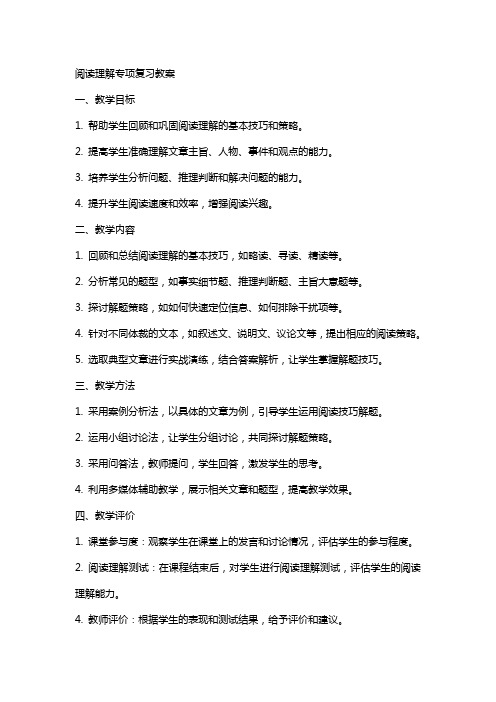
阅读理解专项复习教案一、教学目标1. 帮助学生回顾和巩固阅读理解的基本技巧和策略。
2. 提高学生准确理解文章主旨、人物、事件和观点的能力。
3. 培养学生分析问题、推理判断和解决问题的能力。
4. 提升学生阅读速度和效率,增强阅读兴趣。
二、教学内容1. 回顾和总结阅读理解的基本技巧,如略读、寻读、精读等。
2. 分析常见的题型,如事实细节题、推理判断题、主旨大意题等。
3. 探讨解题策略,如如何快速定位信息、如何排除干扰项等。
4. 针对不同体裁的文本,如叙述文、说明文、议论文等,提出相应的阅读策略。
5. 选取典型文章进行实战演练,结合答案解析,让学生掌握解题技巧。
三、教学方法1. 采用案例分析法,以具体的文章为例,引导学生运用阅读技巧解题。
2. 运用小组讨论法,让学生分组讨论,共同探讨解题策略。
3. 采用问答法,教师提问,学生回答,激发学生的思考。
4. 利用多媒体辅助教学,展示相关文章和题型,提高教学效果。
四、教学评价1. 课堂参与度:观察学生在课堂上的发言和讨论情况,评估学生的参与程度。
2. 阅读理解测试:在课程结束后,对学生进行阅读理解测试,评估学生的阅读理解能力。
4. 教师评价:根据学生的表现和测试结果,给予评价和建议。
五、教学安排1. 课时:共计15课时,每课时45分钟。
2. 教学进度安排:课时1-2:回顾阅读理解的基本技巧和策略。
课时3-4:分析常见的题型和解题策略。
课时5-6:探讨不同体裁文本的阅读策略。
课时7-8:实战演练,选取典型文章进行阅读理解训练。
课时9-10:答案解析,让学生掌握解题技巧。
课时11-12:小组讨论,共同探讨解题策略。
课时13-14:问答环节,教师提问,学生回答。
课时15:阅读理解测试,总结课程内容,给予评价和建议。
六、教学活动1. 设计阅读理解练习题,涵盖不同题型,如事实细节题、推理判断题、主旨大意题等。
2. 安排学生进行自主阅读,让学生运用所学技巧解题。
3. 组织学生进行小组讨论,分享解题心得和经验。
高一上人教版英语必修1学案Unit2 English around the world阅读理解训练学案

Reading Practise编写人:审核人:审批人:1 通过阅读,准确把握文章主旨,提升理解能力。
2激情阅读,合作探究,大胆质疑使用说明与学法指导方法导引: 阅读根据原文选择正确答案,培养快速寻找答案能力。
养成带着问题找答案的习惯。
分层目标:C层完成Reading A ,B , C and D。
A层完成Reading A, B ,C, Dand E 。
AAmer ican middle school students don’t seem to care that they’re worse at maths than their counterparts (同龄人) in China’s Hong Kong and Finland. “I don’t need it,” my student says, “I’m going to be a basketball star.” Or a car mechanic, or a singer.Middle schoo l students’ maths skills were tested by the International Organization for Economic Co-operation and Development. The United States ranked 28th out of 41 countries tested. After all, when was the last time you used algebra (代数)?But maths isn’t just about training Americans to become scientists. It has its own value. It helps you see patterns and develops your logic skills, and it teaches you to concentrate and to separate truth from falsehood. Maths helps you make wise financial decisions, so you can avoid false claims from advertisers, politicians and others. It helps you determine risk. For example, after an airplane crash, studies show that people are more likely to drive than to take a plane in spite of the fact that they are much more likely to be killed or injured while driving. Planes are not like criminals who repeat the same crime over and over. One plane is not more likely to crash just because another plane recently did. In fact, the most dangerous time to drive is probably right after a plane crash because so many people are on the road.It is not possible to really understand science and the scientific method without understanding maths. A rainbow is even more beautiful and amazing when we understand it.The precision (精确性) of maths helps us think in a very special way. How do we bring the learning of maths back to life? I don’t have the big answer. I try my best to help pupils find answers to some maths problems. When I can get one to say, “Wow, that’s great,” I feel th e joy of a small victory.61. Some American students don’t care about their poor maths results because __________.A. maths is useless to most peopleB. they have no interest in mathsC. they think maths has nothing to do with their futureD. t hey don’t do well in maths62. The example in Paragraph 3 is used to show __________.A. every coin has its two sidesB. we should not be cheated by fault factsC. maths is close to our daily lifeD. a simple fact shows complicated rules63. The writer would agree that __________.A. it’s normal that America kids are weak in mathsB. without maths we’ll miss much in our lifeC. maths is the most important subject at schoolD. American kids don’t work hard at school64. This text is most probably written by __________.A. a student career guideB. a researcher on students’ problemsC. a specialist in students’ studiesD. a maths teacherBToo many people want others to be their friends, but they don’t give friendship back. That is why some friendships do not last very long. To have a friend, you must learn to be one. You must learn to treat your friend the way you want your friend treat you. Learning to be a good friend means learning three rules. Be honest; be generous; be understanding.Honesty is where a good friendship starts. Friends must be able to trust one another. If you do not tell the truth, people usually find out. If a friend finds out that you haven’t been honest you may lose your friends’ trust. Good friends always count on one another to speak and act honestly.Generosity means sharing and sharing makes a friendship grow. You do not have to give your lunch money on your clothes of course. Instead you have to learn how to share things you enjoy, like your hobbies and your interest. Naturally you will want to share your ideas and feelings. These can be very valuable to a friend. They tell your friend what is important to you. By sharing them you help your friend know yo u better.Sooner or later every one needs understanding and help with a problem. Something may go wrong at school. Talking about the problem can make it easier to solve. Turning to a friend can be a first step in solving the problem. So to be a friend you must listen and understand. You must try to put yourself in your friend’s place so you can understand the problem better.No two friendships are ever exactly alike. But all true friendships have three things in common. If you plan to keep your friends, you must practise honesty, generosity, and understanding.65. Some friendships don’t last very long because ____.A. there are too many people who want to make friends.B. those who never give others friendships receive no friendship from others.C. those who give others friendship receive friendship from others.D. they don’t know friendship is something serious.66. According to the passage honesty is _____.A. something goodB. the base of friendshipC. as important as moneyD. more important than anything else67. The underlined word “generosity” means ___.A.大度B.节约C.吝啬D.和气68. Which of the following isn’t mentioned (提及)in the passage?A. Always tell your friend the truth.B. Sharing your mind with your friend is of great value.C. Discussing your problems with your friend often helps to solve the problem.D. A friend who gives you his lunch money is a true friend.CHere are a few tips we’ve put together to help you learn English well.Speak, speak, speakPractise speaking as often as you can—even speaking to yourself is good practice.Try recording yourself whenever you can. Compare your pronunciation with the master version, see how you can do better and have another go. If you do this several times, you will find that each version is better than the last.Why not learn with someone else?It helps if you can l earn with someone else. If you can persuade a friend or a family member to study with you, it will make you keep working.Don’t get stuck by a word you don’t know.Practise improvising(即兴的)ways of getting your meaning across when speaking spontaneously(本能地), even if you don’t know the exact words or phrases. Thi nk of things you might want to say whenever you have spare time. Use facial expressions, hand movements, anything to get your meaning across.Language learning is also about intuition(直觉).Guesswork is an important way to learn a new language. When listening to recorded material, you aren’t expected to understand everything first round. If you play the same piece several times, y ou will most probably understand something new each time.Build up your vocabulary.A wide vocabulary is the key to successful language learning but don’t try to learn too much at once. It’s best to study frequently, for short periods of time. Take at most six or seven items of vocabulary and learn them. Put them into sentences to fix them in your mind, then come back to them later.And above all, have fun!69. Why should one have himself recorded when practicing speaking?A. To improve his speaking.B. To record his own progress.C. To encourage others to start.D. To compare himself with others.70. In the writer’s opinion, which of the following is the most important in leaning English?A. Speaking.B. Pleasure.C. Intuition.D. V ocabulary.71. It is implied in the passage that _______ is helpful when you are learning English.A. body languageB. a good materialC. a good friendD. a proper dictionary72. According to the passage, one should ______ when you are learning English.A. always work with other peopleB. be able to guess everything newC. often review what he has learntD. take little notice of grammarDParents should stop blaming themselves because there’s not a lot they can do about it. I mean the teenager problem. Whatever you do or however you choose to deal with it, at certain times a wonderful, reasonable and helpful child will turn into a terrible animal.I’ve seen friends deal with it in all kinds of different ways. One strict mother insisted that her son, right from a child, should stand up whenever anyone entered the room, open doors and shake hands like a gentleman. I saw him last week when I called round. Sprawling himself (懒散地躺) on the sofa in full length, he made no attempt to turn off the loud TV he was watching as I walked in, and his greeting was no more than a quick glance at me. His mother was ashamed. “I don't know what to do with him these days,” she said. “He’s forgotten all the manners we taught him.”He hasn’t forgotten them. He’s just decided that he’s not going to use them. She confessed (坦白) that she would like to come up behind him and throw him down from the sofa onto the floor.Another good friend of mine let her two daughters climb all over the furniture, reach across the table, stare at me and say, “I don’t like your dress; it’s ugly.” One of the daughters has recently been driven out of school. The other has left home.“Where did we go wrong?” her parents are now very sad. Probably nowhere much. At least, no more than the rest of that unfortunate race, parents.73. This text is most probably written by ______.A. a specialist(专家)in teenager studiesB. a headmaster of a middle schoolC. a parent with teenage childrenD. a doctor for mental health problems74. The underlined word “it” in the second paragraph refers to ______.A. the change from good to bad that’s seen in a childB. the way that parents often blame themselvesC. the opinion that a child has of his parentsD. the advice that parents want their children to follow75. From the second example we can infer that the parents of the two daughters __.A. pay no attention to themB. are too busy to look after themC. have come to hate themD. feel helpless to do much about them76. What is the author’s opinion about the sudden change in teenage children?A. Parents have no choice but to try to accept it.B. Parents should pay still some attention to the change.C. Parents should work more closely with school teachers.D. Parents are at fault for the change in their children.EDo dogs understand us?Be careful what you say around your dog. It might understand more than you think.A border collie named Rico recognizes the names of about 200 objects, say researchers in Germany. The dog also appears to be able to learn new words as easily as a 3-year-old child. Its word-learning skills are as good as those of a parrot or chimpanzee.In one experiment, the researchers took all 200 items that Rico is supposed to know and divided them into 20 groups of 10 objects. Then the owner told the dog to go and fetch one of the items and bring it back. In four tests, Rico got 37 out of 40 commands right. As the dog couldn't see anyone to get clues, the scientists believe Rico must understand the meanings of certain words.In another experiment, the scientists took one toy that Rico had never seen before and put it in a room with seven toys whose names the dog already knew. The owner then told Rico to fetch the object, using a word the dog had never heard before.The correct object was chosen in seven out of ten tests, suggesting that the dog had workedout the answer by process of elimination(排除法). A month later, Rico remembered half of the new names, which is even more impressive.Rico is thought to be smarter than the average dog. For one thing, Rico is a border collie, a breed (品种)known for its m ental abilities. In addition, the 9-year-old dog has been trained to fetch toys by their names since the age of nine months.It's hard to know if all dogs understand at least some of the words we say. Even if they do, they can't talk back. Still, it wouldn't hurt to sweet-talk your dog every now and then. You might just get a big, wet kiss in return!77. From paragraph 2 we know that __ .A. animals are as clever as human beingsB. chimpanzees have very good word-learning skillsC. dogs are smarter than parrots and chimpanzeesD. dogs have similar learning abilities as 3-year-old children78. Both experiments show that .A. Rico is smart enough to get all commands rightB. Rico can recognize different things including toysC. Rico has developed the ability of learning mathematicsD. Rico won't forget the names of objects once recognizing them79. Which of the following statements is true?A. Rico has a better memory partly because of its proper early training.B. The purpose of the experiments is to show the border collie's mental abilities.C. The border collie is world-famous for recognizing objects.D. Rico is born to understand its owner's commands.80. What does the writer want to tell us?A. To train your dog.B. To talk to your dog.C. To be careful with your dog.D. To be friendly to your dog.。
阅读理解专项复习教案
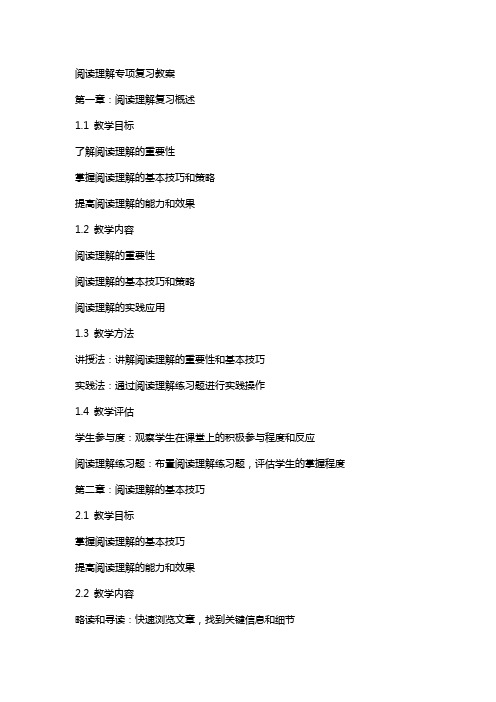
阅读理解专项复习教案第一章:阅读理解复习概述1.1 教学目标了解阅读理解的重要性掌握阅读理解的基本技巧和策略提高阅读理解的能力和效果1.2 教学内容阅读理解的重要性阅读理解的基本技巧和策略阅读理解的实践应用1.3 教学方法讲授法:讲解阅读理解的重要性和基本技巧实践法:通过阅读理解练习题进行实践操作1.4 教学评估学生参与度:观察学生在课堂上的积极参与程度和反应阅读理解练习题:布置阅读理解练习题,评估学生的掌握程度第二章:阅读理解的基本技巧2.1 教学目标掌握阅读理解的基本技巧提高阅读理解的能力和效果2.2 教学内容略读和寻读:快速浏览文章,找到关键信息和细节理解主旨和主题:把握文章的中心思想和主题推断和预测:根据文章内容和上下文推断未知信息理解因果关系:识别文章中的因果关系,理解逻辑关系2.3 教学方法讲授法:讲解阅读理解的基本技巧实践法:通过阅读理解练习题进行实践操作2.4 教学评估阅读理解练习题:布置阅读理解练习题,评估学生的掌握程度第三章:阅读理解的策略3.1 教学目标掌握阅读理解的策略提高阅读理解的能力和效果3.2 教学内容利用上下文线索:通过上下文信息推断未知词汇和意义理解和分析作者观点:识别作者的观点和态度总结和归纳:对文章内容进行总结和归纳3.3 教学方法讲授法:讲解阅读理解的策略实践法:通过阅读理解练习题进行实践操作3.4 教学评估阅读理解练习题:布置阅读理解练习题,评估学生的掌握程度第四章:阅读理解的实践应用4.1 教学目标运用阅读理解的技巧和策略提高阅读理解的应用能力4.2 教学内容不同类型的阅读材料:报纸、杂志、小说、报告等不同题型的阅读理解题目:选择题、填空题、问答题等实践应用:通过实际阅读材料进行阅读理解练习4.3 教学方法讲授法:讲解不同类型的阅读材料和题型实践法:通过实际阅读材料进行阅读理解练习4.4 教学评估阅读理解练习题:布置实际阅读材料,评估学生的应用能力第五章:阅读理解的提高和拓展5.1 教学目标进一步提高阅读理解的能力拓展阅读理解的领域和范围5.2 教学内容阅读理解的提高技巧:词汇积累、阅读笔记、思维导图等阅读理解的拓展领域:文学、科学、历史、文化等阅读理解的拓展资源:图书馆、网络、阅读俱乐部等5.3 教学方法讲授法:讲解提高阅读理解能力和拓展领域的技巧和方法实践法:通过实际阅读材料进行阅读理解练习5.4 教学评估阅读理解练习题:布置实际阅读材料,评估学生的提高程度第六章:常见阅读理解障碍及对策6.1 教学目标识别常见的阅读理解障碍学会应对阅读理解障碍的策略6.2 教学内容词汇障碍:不熟悉文章中的专业词汇或生词语法障碍:难以理解复杂的句子结构和语法文化背景障碍:不熟悉文章中的文化背景和习俗逻辑思维障碍:难以理解文章的逻辑和论证过程对策:查字典、上下文推断、背景知识补充、梳理逻辑关系6.3 教学方法讲授法:讲解阅读理解障碍的类型及对策小组讨论法:分组讨论实际案例,共同探讨解决障碍的方法6.4 教学评估案例分析:布置含有阅读障碍的文章,评估学生识别和解决障碍的能力第七章:阅读理解策略在实际考试中的应用7.1 教学目标学会将阅读理解策略应用于考试中提高考试中阅读理解部分的得分能力7.2 教学内容考试中阅读理解题型的特点如何在考试中运用略读、寻读、推断等策略时间管理:如何在有限的时间内完成阅读理解题目应试技巧:答题顺序、标记重要信息、审题等7.3 教学方法讲授法:讲解考试中阅读理解题型的特点及应试技巧模拟考试:进行阅读理解模拟考试,指导学生应用策略7.4 教学评估模拟考试:分析学生在模拟考试中的表现,评估其应用策略的能力第八章:阅读理解的拓展训练8.1 教学目标拓展阅读理解的深度和广度培养学生的阅读兴趣和阅读习惯8.2 教学内容深度阅读:分析文章的深层含义、作者的写作技巧等跨学科阅读:结合不同学科的知识进行阅读理解阅读计划:制定个人的阅读计划,持续进行阅读训练8.3 教学方法讲授法:讲解深度阅读和跨学科阅读的方法实践法:鼓励学生进行阅读实践,分享阅读心得8.4 教学评估阅读心得:收集学生的阅读心得,评估其拓展阅读的效果第九章:阅读理解与写作的结合9.1 教学目标学会将阅读理解与写作相结合提高写作能力和思维品质9.2 教学内容阅读理解在写作中的作用:提供素材、拓展思维、提高论证能力等写作中的阅读理解技巧:理解文章结构、提炼观点、运用恰当的论证方法等实践训练:以阅读理解为基础进行写作训练9.3 教学方法讲授法:讲解阅读理解在写作中的作用及技巧实践法:进行以阅读理解为基础的写作训练9.4 教学评估写作作品:评估学生在写作中运用阅读理解的能力和写作质量第十章:阅读理解的综合训练与评价10.1 教学目标进行阅读理解的综合训练评价学生的阅读理解能力10.2 教学内容综合训练:结合前面所学内容,进行阅读理解的综合训练评价方法:自评、互评、教师评价等多种评价方式10.3 教学方法实践法:进行阅读理解的综合训练评价法:采用多种评价方式,对学生的阅读理解能力进行评价10.4 教学评估综合训练成果:评估学生在综合训练中的表现评价结果:分析学生的自评、互评和教师评价,了解学生的学习效果重点和难点解析在上述教案中,需要重点关注的环节包括:1. 阅读理解的重要性:这一环节需要强调阅读理解在学术和个人发展中的核心地位,以及它如何关联到学生的其他学习领域。
部编初三初中语文课外阅读理解解题技巧教案+专项训练练习题(含答案解析)
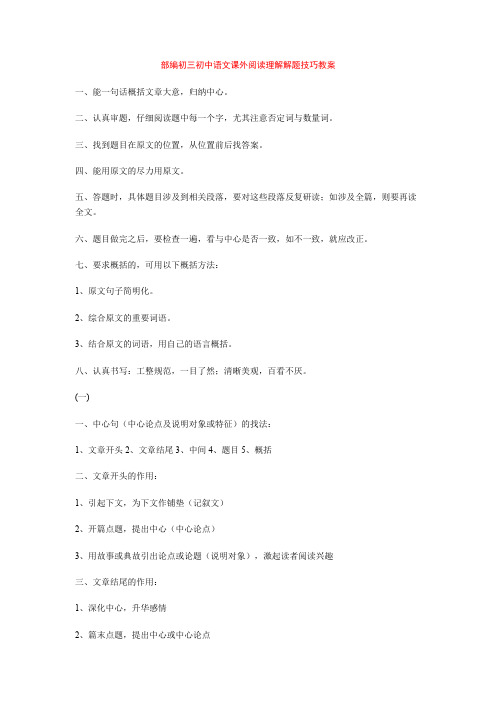
部编初三初中语文课外阅读理解解题技巧教案一、能一句话概括文章大意,归纳中心。
二、认真审题,仔细阅读题中每一个字,尤其注意否定词与数量词。
三、找到题目在原文的位置,从位置前后找答案。
四、能用原文的尽力用原文。
五、答题时,具体题目涉及到相关段落,要对这些段落反复研读;如涉及全篇,则要再读全文。
六、题目做完之后,要检查一遍,看与中心是否一致,如不一致,就应改正。
七、要求概括的,可用以下概括方法:1、原文句子简明化。
2、综合原文的重要词语。
3、结合原文的词语,用自己的语言概括。
八、认真书写:工整规范,一目了然;清晰美观,百看不厌。
(一)一、中心句(中心论点及说明对象或特征)的找法:1、文章开头2、文章结尾3、中间4、题目5、概括二、文章开头的作用:1、引起下文,为下文作铺垫(记叙文)2、开篇点题,提出中心(中心论点)3、用故事或典故引出论点或论题(说明对象),激起读者阅读兴趣三、文章结尾的作用:1、深化中心,升华感情2、篇末点题,提出中心或中心论点3、总结上文,提出倡议,发出号召四、一句话或一段话的作用:1、结构上的作用是:总起全文、引起下文、打下伏笔、作铺垫、承上启下(过渡)、前后照应、首尾呼应、总结全文、点题、推动情节发展.2、语句在表情达意方面的作用:渲染气氛、烘托人物形象(或人物感情)、点明中心(揭示主旨)、突出主题(深化中心)。
①、充当事实论据,证明前(后)一句话,进而证明中心论点;②充当道理论据,证明前(后)一句话,进而证明中心论点;③说明了前(后)一话(说明事物的特征)(二)一、常见写作方法、表现手法::联想、想像、象征、比较、对比、衬托、烘托、反衬、欲扬先抑、先抑后扬、以小见大、托物言志、借物喻理、寓理于物、借物喻人、状物抒情、借景抒情、情景交融、借物抒情、借古喻今、运用典故、直接抒情、动静结合、虚实结合、正面描写、侧面描写等。
二、“这”、“它们”等指代什么:1、一般是往前找,不会超出前三句;2、找到之后,将找到的内容放在指代词所在句中读一读,看是否适合。
七年级语文下下学期期末复习 阅读理解专题导学案(2)(无答案)(新版)新人教版

期末复习阅读理解专题知识再现——复习第2、4、6单元,掌握散文阅读答题技巧一.散文阅读的方法:1.找“要素”2.理顺序3.抓线索4.品语言5.析情感或哲理二.常见的表现手法有:,寓情于景,情景交融,移情于景,托物言志,借古讽今,直抒胸臆,对比衬托,象征,卒章显志,讽喻,动静结合(、、),虚实结合等。
三.谈感受关键是:①能准确读懂原文的含义和作者的思想情感。
②要有自己明确的观点或态度。
③答题时,语言要流畅。
不能出病句,语言要有层次性,可以引用诗文或名言回答此题。
当堂考试(共100分)一、阅读下文,完成1--4题。
( 40分)母狼的智慧⑴“仅次于人的聪明的动物,是狼,是北方的狼。
南方的狼是什么样,我不知道。
不知道的事不瞎说,我只知道北方的狼。
”⑵一位老猎人,在大兴安岭蜂蜜般的黏稠的篝火旁,对我说。
猎人是个渐渐消亡的职业,他不再打猎,成了护林员。
⑶我说:“不对。
是大猩猩。
大猩猩有表情,会使用简单的工具,甚至能在互联网上用特殊的语言与人交流。
”⑷“我没见过大猩猩,也不知道互联网是什么东西。
我只见过狼。
沙漠和森林交界地方的狼,最聪明。
那是我年轻的时候啦……”老猎人舒展胸膛,好像恢复了当年的神勇。
⑸“狼带着小狼过河,怎么办呢?要是只有一只小狼,它会把它叼在嘴里。
若有好几只,它不放心一只只带过去,怕它在河里游的时候,留在岸边的子女会出什么事。
于是,狼就咬死一只动物,把那动物的胃吹足了气,再用牙齿牢牢紧住蒂处,让它胀鼓鼓的好似一只皮筏。
它把所有的小狼背负在身上,借着那救生圈的浮力,全家过河。
”⑹“有一次,我追捕一只带有两只小崽的母狼。
它跑得不快,因为小狼脚力不健。
我和狼的距离渐渐缩短,狼妈妈转头向一座巨大的沙丘爬去。
我很吃惊。
通常狼在危机时,会在草木旺盛处兜圈子,借复杂地形伺机脱逃。
如果爬向沙坡,狼虽然爬得快,好像比人占便宜,但人一旦爬上山坡,就一览无余,狼就再也跑不了。
”⑺“这是一只奇怪的狼,也许它昏了头。
我这样想着,一步一滑爬上了高高的沙丘。
三年级阅读理解专项训练教案

三年级阅读理解专项训练教案一、教学目标1、让学生掌握基本的阅读技巧,如快速浏览、精读、略读等。
2、提高学生对文章内容的理解能力,能够准确把握文章的主旨大意、细节信息、作者观点等。
3、培养学生的推理和判断能力,能够根据文章内容进行合理的推理和判断。
4、增强学生的词汇积累和语言表达能力,通过阅读学习新的词汇和表达方式,并能够运用到自己的写作和口语中。
二、教学重难点1、重点(1)帮助学生掌握不同类型文章(记叙文、说明文、议论文等)的阅读方法和技巧。
(2)指导学生如何从文章中提取关键信息,理解文章的主旨大意。
2、难点(1)培养学生对文章深层含义的理解和分析能力,能够理解作者的写作意图和情感态度。
(2)提高学生在阅读中的推理和判断能力,能够解决一些较为复杂的阅读问题。
三、教学方法1、讲授法:讲解阅读理解的基本知识和技巧,让学生对阅读有初步的认识和理解。
2、练习法:通过大量的阅读练习,让学生在实践中掌握阅读技巧,提高阅读能力。
3、讨论法:组织学生对阅读材料进行讨论,分享自己的理解和看法,培养学生的思维能力和语言表达能力。
4、归纳法:引导学生对阅读练习中的问题和错误进行归纳总结,找出规律和方法,提高阅读水平。
四、教学过程1、导入(5 分钟)通过讲述一个有趣的小故事或者展示一篇简短的文章,引起学生的兴趣,然后提问学生对这个故事或文章的理解,从而引出阅读理解的主题。
2、知识讲解(15 分钟)(1)介绍阅读理解的重要性和基本概念,让学生明白阅读理解不仅是考试中的重要部分,也是获取知识和信息的重要途径。
(2)讲解不同类型文章(记叙文、说明文、议论文等)的特点和阅读方法。
例如,记叙文要关注事件的起因、经过和结果,人物的性格和情感;说明文要注意说明对象的特征、说明方法和顺序;议论文要把握论点、论据和论证过程。
(3)介绍阅读技巧,如快速浏览、精读、略读等。
快速浏览可以帮助学生在短时间内了解文章的大致内容;精读则用于深入理解文章的重点部分;略读适用于不重要的内容或者为了寻找特定信息。
- 1、下载文档前请自行甄别文档内容的完整性,平台不提供额外的编辑、内容补充、找答案等附加服务。
- 2、"仅部分预览"的文档,不可在线预览部分如存在完整性等问题,可反馈申请退款(可完整预览的文档不适用该条件!)。
- 3、如文档侵犯您的权益,请联系客服反馈,我们会尽快为您处理(人工客服工作时间:9:00-18:30)。
阅读理解专项训练(一)--把握主旨大意
阅读理解题型分类
主旨大意题、细节理解题、推理判断题、猜测词义型、作者的观点态度、文章来源等
一、主旨大意题型分类
标题类(title)、段落大意(main idea of the paragraph)、文章主旨(main idea of the passage)
1.文章主旨类试题中常见的题干
(1) The passage is mainly about ...
(2) What is the text mainly about?
二、主旨大意类解题方法
1.寻找主题句(关注文章结构)
2. 推敲选项,排除干扰
3. 概括全文,寻找文章中心思想
2012年课程标准卷
D
Grown-ups are often surprised by how well they remember something they learned as children but have never practiced ever since. A man who has not had a chance to go swimming for years can still swim as well as ever when he gets back in the water. He can get on a bicycle after many years and still ride away. He can play catch and hit a ball as well as his son. A mother who has not thought about the words for years can teach her daughter the poem that begins“Twinkle,twinkle,little star”or remember the story of Cinderella or Goldilocks and the Three Bears.
One explanation is the law of over learning,...
67.What is the main idea of Paragraph 1?
A.People remember well what they learned in childhood.
B.Children have a better memory than grown-ups.
C.Poem reading is a good way to learn words.
D. Stories for children are easy to remember.
2012年安徽高考
E
Welcome to your future life!
You get up in the morning and look into the mirror.your face is firm and young-looking. In 2035,medical technology is better than ever. Many people your age could live to be 150,so at 40,you’re not old at all. And your parents just had an anti-aging(抗衰老的)treatment. Now, all three of you look the same age.
You say to your shirt,“Turn red.”It changes from blue to red. In 2035,“smart clothes”contain particles(粒子) much smaller than the cells in your body. The particles can be programmed to change your clothes’color or pattern.
You walk into the kitchen. You pick up the milk, but a voice says,“You shouldn’t drink that!”Your fridge has read the chip(芯片) that contains information about the milk, and it knows the milk is old. In 2035,every article of food in the grocery store has such a chip.
It’s time to go to work. In 2035,cars drive themselves. Just tell your “smart car”where to go. On the way, you can call a friend using your jacket sleeve. Such “smart technology”is all around you.
So will all these things come true?“For new technology to succeed,”says scientist Andrew Zolli,“it has to be so much better that it replaces what we have already.”The Internet is one example—what will be the next?
75. What is the text mainly about?
A.Food and clothing in 2035.
B.Future technology in everyday life.
C.Medical treatments of the future.
D.The reason for the success of new technology.。
